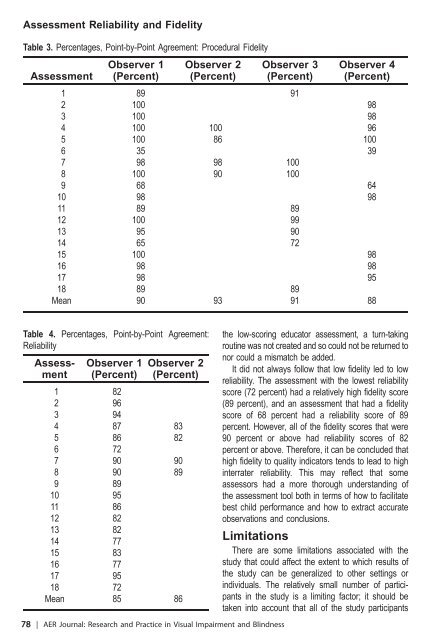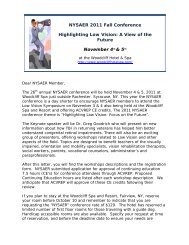Association for Education and Rehabilitation of the ... - AER Online
Association for Education and Rehabilitation of the ... - AER Online
Association for Education and Rehabilitation of the ... - AER Online
You also want an ePaper? Increase the reach of your titles
YUMPU automatically turns print PDFs into web optimized ePapers that Google loves.
Assessment Reliability <strong>and</strong> Fidelity<br />
Table 3. Percentages, Point-by-Point Agreement: Procedural Fidelity<br />
Assessment<br />
Observer 1 Observer 2 Observer 3Observer 4<br />
(Percent) (Percent) (Percent) (Percent)<br />
1 89 91<br />
2 100 98<br />
3 100 98<br />
4 100 100 96<br />
5 100 86 100<br />
6 35 39<br />
7 98 98 100<br />
8 100 90 100<br />
9 68 64<br />
10 98 98<br />
11 89 89<br />
12 100 99<br />
13 95 90<br />
14 65 72<br />
15 100 98<br />
16 98 98<br />
17 98 95<br />
18 89 89<br />
Mean 90 93 91 88<br />
Table 4. Percentages, Point-by-Point Agreement:<br />
Reliability<br />
Assessment<br />
Observer 1<br />
(Percent)<br />
Observer 2<br />
(Percent)<br />
1 82<br />
2 96<br />
3 94<br />
4 87 83<br />
5 86 82<br />
6 72<br />
7 90 90<br />
8 90 89<br />
9 89<br />
10 95<br />
11 86<br />
12 82<br />
13 82<br />
14 77<br />
15 83<br />
16 77<br />
17 95<br />
18 72<br />
Mean 85 86<br />
78 | <strong>AER</strong> Journal: Research <strong>and</strong> Practice in Visual Impairment <strong>and</strong> Blindness<br />
<strong>the</strong> low-scoring educator assessment, a turn-taking<br />
routine was not created <strong>and</strong> so could not be returned to<br />
nor could a mismatch be added.<br />
It did not always follow that low fidelity led to low<br />
reliability. The assessment with <strong>the</strong> lowest reliability<br />
score (72 percent) had a relatively high fidelity score<br />
(89 percent), <strong>and</strong> an assessment that had a fidelity<br />
score <strong>of</strong> 68 percent had a reliability score <strong>of</strong> 89<br />
percent. However, all <strong>of</strong> <strong>the</strong> fidelity scores that were<br />
90 percent or above had reliability scores <strong>of</strong> 82<br />
percent or above. There<strong>for</strong>e, it can be concluded that<br />
high fidelity to quality indicators tends to lead to high<br />
interrater reliability. This may reflect that some<br />
assessors had a more thorough underst<strong>and</strong>ing <strong>of</strong><br />
<strong>the</strong> assessment tool both in terms <strong>of</strong> how to facilitate<br />
best child per<strong>for</strong>mance <strong>and</strong> how to extract accurate<br />
observations <strong>and</strong> conclusions.<br />
Limitations<br />
There are some limitations associated with <strong>the</strong><br />
study that could affect <strong>the</strong> extent to which results <strong>of</strong><br />
<strong>the</strong> study can be generalized to o<strong>the</strong>r settings or<br />
individuals. The relatively small number <strong>of</strong> participants<br />
in <strong>the</strong> study is a limiting factor; it should be<br />
taken into account that all <strong>of</strong> <strong>the</strong> study participants







